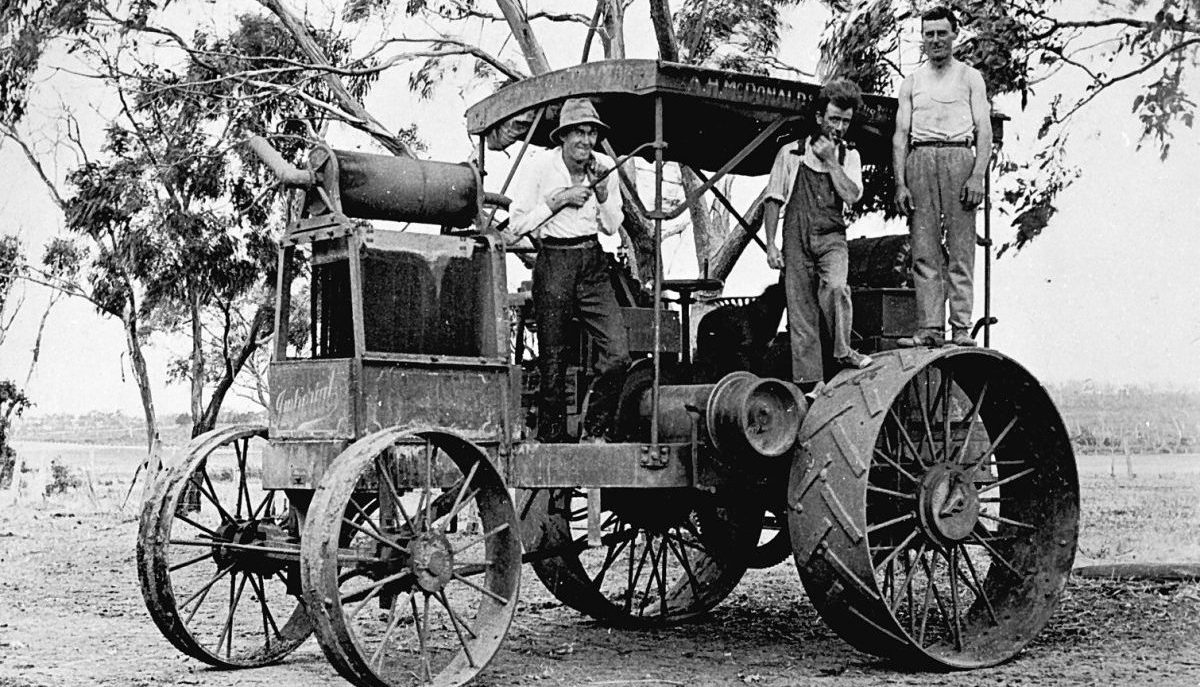
Three men, possibly Bennetts family members, with the EB tractor at French Island in 1926. Photo: G Bennetts/Museums Victoria
ONE of the earliest surviving tractors manufactured in Australia has been acquired by the National Museum of Australia in Canberra.
The tractor spent much of its recent life in the United States in private ownership but returned to Australia following its sale at auction in 2020.
It was acquired in 2021 by the National Museum for $250,000, with the support of an anonymous benefactor and the Australian Government through the National Cultural Heritage Account.
The McDonald Imperial EB oil tractor was purchased new in 1912 by Frank William Chilcott for use at Lillesdon Park, his 403-acre farm located on French Island in Victoria’s Western Port Bay.
It was manufactured in the same year at the AH McDonald & Co factory in Stawell Street, Richmond, and is an example of how brothers Alfred and Ernest McDonald adapted imported tractors to suit Australian conditions.

Brothers Alfred and Ernest McDonald.
Alfred set up his workshop in 1903, and in 1908 he and Ernest produced the first Australian-made oil tractor, known as the EA, which marked the transition between steam-powered traction engines and internal combustion-engine tractors.
The improved design of the EB followed in 1912, and the model adds to the museum’s National Historical Collection and supports its mission to tell remarkable stories from Australian history.
The machine provides an insight into the global transformation in automotive and agricultural practices triggered by the invention of the oil-driven, internal combustion engine in the 1870s.
National Museum director Mathew Trinca thanked the Australian Government for its financial assistance with the purchase of the tractor, which he said is an unrivalled example of Australian ingenuity and design.
“The McDonald EB oil tractor represents a theme of Australian innovation in a revolutionary era for engineering,” Dr Trinca said.
“This acquisition represents our agricultural history, and we are thrilled to share it with Australia.”
It was likely used for land clearing as part of the local chicory cultivation industry, which was a prolific industry on French Island until the mid-1960s.
The arrival of the tractor on French Island was a memorable event that required a police escort from the McDonald factory in Melbourne.
“When Frank’s small nephew (Garth Bennetts) saw it coming over the hill to his island home, he took fright, ran inside, and hid under the bed,” local Ruth Gooch recounted.
Mr Chilcott died in 1919, and the tractor passed to his brother-in-law, Richard Bennetts.
The tractor’s survival is testament to many local enthusiasts who are committed to preserving important early agricultural machinery.

The 1912 McDonald EB Imperial tractor no. 140 is on display in the Gandel Atrium. Photo: Jason McCarthy/NMA
Museum curator Ian Coates, who coordinated the acquisition of the tractor, said it has historic significance because of its association with Australia’s first tractor manufacturer.
“Perhaps the most remarkable aspect of the early tractors produced by AH McDonald & Co was the relative sophistication of their engineering, which included coil ignition, a three-speed gearbox and automotive rack-and-pinion steering,” Dr Coates said.
“This reflects Alf McDonald’s capacity to improve the contemporary design of imported American tractors,” Dr Coates said.
Source: National Museum of Australia

HAVE YOUR SAY